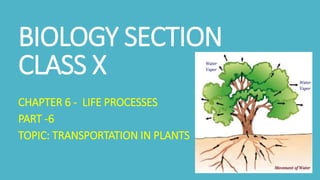
Transportation in Plants Explained
- 1. BIOLOGY SECTION CLASS X CHAPTER 6 - LIFE PROCESSES PART -6 TOPIC: TRANSPORTATION IN PLANTS
- 2. Plants take in simple compounds such as CO2 and water to photosynthesise energy stored in their chlorophyll-containing organs (leaves). The other raw materials like nitrogen, phosphorus etc. needed for building plant bodies are absorbed through the roots. If the distances between soil-contacting organs and chlorophyll containing organs are small, energy and raw materials can easily diffuse to all parts of the plant body. But if these distances become large because of changes in plant body design, diffusion processes will not be sufficient to provide raw material in leaves and energy in roots. Transportation in plants
- 3. Plants do not move, and plant bodies have a large proportion of dead cells in many tissues. As a result, plants have low energy needs, and can use relatively slow transport systems. The distances over which transport systems have to operate can be very large in plants such as very tall trees. Plant transport systems will move energy stores from leaves and raw materials from roots. These two pathways are constructed as independently organised conducting tubes. The xylem moves water and minerals obtained from the soil and the phloem transports products of photosynthesis from the leaves where they are synthesised to other parts of the plant. (translocation). Transportation in plants
- 4. Plants have tissues to transport water, nutrients and minerals. Xylem transports water and mineral salts from the roots up to other parts of the plant, while phloem transports sucrose and amino acids between the leaves and other parts of the plant. Xylem, normally, consists of tracheid, vessels, xylem parenchyma, and xylem fibers. Phloem, normally, is made up of four types of elements namely − Sieve tubes, Companion cells, Phloem fibers and Phloem parenchyma Transportation in plants XYLEM AND PHLOEM (COMPLEX PERMANENT TISSUE)
- 5. XYLEM AND PHLOEM (COMPLEX PERMANENT TISSUE)
- 6. XYLEM AND PHLOEM (COMPLEX PERMANENT TISSUE) Xylem, normally, consists of tracheid, vessels, xylem parenchyma, and xylem fibers. Phloem, normally, is made up of four types of elements namely − Sieve tubes, Companion cells, Phloem fibers and Phloem parenchyma
- 7. XYLEM AND PHLOEM (COMPLEX PERMANENT TISSUE)
- 8. In xylem tissue, vessels and tracheids of the roots, stems and leaves are interconnected to form a continuous system of water-conducting channels reaching all parts of the plant. At the roots, cells in contact with the soil actively take up ions. This creates a difference in the concentration of these ions between the root and the soil. Water, therefore, moves into the root from the soil to eliminate this difference. This means that there is steady movement of water into root xylem, creating a column of water that is steadily pushed upwards. However, this pressure by itself is unlikely to be enough to move water over the heights in plants. Plants use another strategy to move water in the xylem upwards to the highest points of the plant body. Transport of water Channel: a tubular passage or duct for liquid.
- 9. Provided that the plant has an adequate supply of water, the water which is lost through the stomata is replaced by water from the xylem vessels in the leaf. In fact, evaporation of water molecules from the cells of a leaf creates a suction which pulls water from the xylem cells of roots. The loss of water in the form of vapour from the aerial parts (e.g. leaves) of the plant is known as transpiration. Thus, transpiration helps in the absorption and upward movement of water and minerals dissolved in it from roots to the leaves. It also helps in temperature regulation. The effect of root pressure in transport of water is more important at night. During the day when the stomata are open, the transpiration pull becomes the major driving force in the movement of water in the xylem. Transport of water
- 10. The products of metabolic processes, particularly photosynthesis, are moved from leaves, where they are formed, to other parts of the plant. This transport of soluble products of photosynthesis is called translocation and it occurs in the part of the vascular tissue known as phloem. Besides the products of photosynthesis, the phloem transports amino acids and other substances. These substances are especially delivered to the storage organs of roots, fruits and seeds and to growing organs. The translocation of food and other substances takes place in the sieve tubes with the help of adjacent companion cells both in upward and downward directions. Transport of food and other substances
- 11. Unlike transport in xylem which can be largely explained by simple physical forces, the translocation in phloem is achieved by utilising energy. Material like sucrose is transferred into phloem tissue using energy from ATP. This increases the osmotic pressure of the tissue causing water to move into it. This pressure moves the material in the phloem to tissues which have less pressure. This allows the phloem to move material according to the plant’s needs. For example, in the spring, sugar stored in root or stem tissue would be transported to the buds which need energy to grow. Transport of food and other substances
- 12. 1. What are the components of the transport system in highly organised plants? 2. How are water and minerals transported in plants? 3. How is food transported in plants? 4. What do you mean by transpiration and translocation? 5. What are the elements of Xylem and Phloem? 6. What are xylem and phloem? 7. Plants have relatively slow transport systems. Why? 8. Name the raw materials that plants use to photosynthesise energy stored in their chlorophyll-containing organs. 9. What is the role of transpiration in plants? 10. What do you mean by vascular tissues? Name the vascular tissues in plants. 11. Name the substances transported by phloem. QUESTIONS